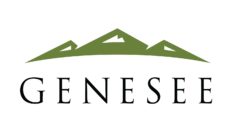Wildfire Safety
Wildfire safety at a glance:
Inventory your possessions and create evacuation checklists, mitigate your property, harden your home, evacuate safely and quickly.
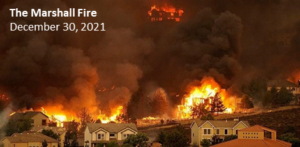
The Big Picture
Wildfire safety is best served by not only personal and family safety, but also by actions of the community at large. The links in the two following sections on this page, Making Your Family Safe, and Making Your Community Safer, provide more detail about what you can do.
A NOTE about information sources and resources
There is an almost overwhelming amount of information on wildfires, and actions to be taken by those of us living in the Wildland-Urban Interface (WUI). The links provided here are only a very small part of that information and have been chosen for their clarity and applicability to our Genesee environment.
The Genesee Fire & Safety Committee welcomes suggestions for changes to the list.
Making your family safe: Two approaches to wildfire safety
Approach 1: Inventory/Mitigate/Harden/Evacuate: An introduction
If one begins to look for information about improving the safety of their family and property when considering wildfire dangers, it is easy to quickly become overwhelmed by the amount of information from various sources (especially on the web) and by the amount and range of tasks that are recommended to accomplish.
One approach that can be used is to separate the tasks into four general categories, to look at those categories being accomplished in the context of a timeline, and to assess the order in which to work on those tasks based on the circumstances of your family and location.
The I/M/H/E approach: Inventory/Mitigate/Harden/Evacuate.
Inventory your possessions/Mitigate your property/Harden your home/Evacuate your family.
The threats to your life, home and possessions can be minimized, and your recovery from wildfire can be enhanced by addressing four general categories. To be most effective the areas need to be addressed from well before a fire threatens to immediately before a fire directly threatens you and your family:
- Inventory your possessions, inventory the structures on your property, AND have evacuation checklists prepared and readily available.
- Mitigate the property around your house to minimize the spread of fire.
- Harden the structures on your property to minimize their flammability.
- Evacuate your family, visitors, and pets, and know where to meet after evacuation.
The graphic below is a rough attempt to show how long it might take to do each of the four general categories, although for the first three categories, once each is set up, the maintenance of each should take a lot less time.

Some comments about the graphic and the estimated time:
- For Inventory, Mitigate, and Harden, the longest estimated times are expected as the work on each category is begun. The work to maintain each category should take significantly less time.
- For example, it may take months to schedule and pay for mitigation of your property the first time it is done, but continued routine mitigation (cutting grasses, trimming shrubs and trees, etc.) may only take a day or less.
- A critical part of the Inventory phase is the creation of checklists which remind you of what to pack and take with you when you evacuate, who you will notify when you leave and where you will meet.
- Work related to inventory, mitigation, and hardening can occur largely at the same time, especially if contractors are hired to do at least some of the work.
- The time of evacuation will depend on the timing of warnings from local emergency agencies, and on how well inventory, mitigation and hardening have been done beforehand. If you have prepared well, the time between when you receive the warning and when you leave can be very fast and organized.
Inventory your possessions and create your evacuation checklists.
Sign up for alerts. Identify everything that you own. Plan for evacuation.
Talk to your insurance agent!
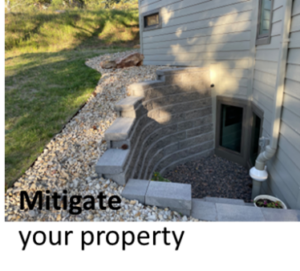 Mitigate your property.
Mitigate your property.
Create space around your home that won’t set your house on fire. (This does NOT mean creating a completely barren space around your home.
 Harden your home.
Harden your home.
Increase the fire resistance of your home.
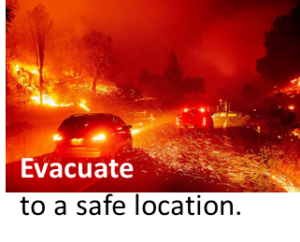 Evacuate your family/visitors/pets/possessions.
Evacuate your family/visitors/pets/possessions.
Know when, how and where to leave, and who and what to take.
Approach 2: Are you wildfire ready? READY * SET * GO!
Evergreen Rotary Wildfire Ready
This second approach leads to the same results in readiness for the arrival of a wildfire but by using a different approach to getting the same tasks accomplished. The one that you use will depend on your personal preferences and situation.
The Rotary Wildfire Ready site contains an almost-overwhelming amount of data, often with many different topics on each (long) page. For those new to the site, it may be best to start with the menu at the top of the page, looking for specific topics of interest.
Steps in the READY * SET * GO! approach are not detailed here, as they are explained and maintained on the Rotary Wildfire Ready website.
Making your community safer
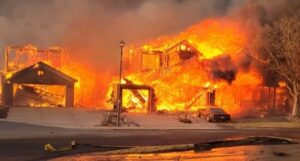 Community wildfire safety is addressed by a variety of local organizations, including the Genesee Foundation (especially through the Fire and Safety Committee), Genesee Fire Protection District (especially through Genesee Fire Rescue, Jefferson County Sheriff, and Genesee Water and Sanitation).
Community wildfire safety is addressed by a variety of local organizations, including the Genesee Foundation (especially through the Fire and Safety Committee), Genesee Fire Protection District (especially through Genesee Fire Rescue, Jefferson County Sheriff, and Genesee Water and Sanitation).
Ongoing work and projects can be found at (CWPP).
When a wildfire approaches, can I go to a designated area in Genesee instead of evacuating completely away from Genesee?
NO!
“Sheltering in place during a wildfire rather than evacuating is a worst-case, last-ditch effort.” The 2021 Genesee Fire Protection District Community Wildfire Protection Plan (CWPP) examined the district for any areas that might serve as a safe area for residents to shelter-in-place and found none. There are no safe areas to shelter-in-place during a wildfire evacuation event within Genesee. Because of the physical environment of Genesee, there are no places that can be developed into a safe area. See CWPP, pages 58 and 59 for details. (Brian Maillet, Genesee Open Space Manager, April 2023)
“Why are they cutting down all the trees?”
The front range of Colorado has an unhealthy and overly dense forest which is the result of more than a century of wildfire suppression. Fire is a natural process in our landscape that acts as a check on overgrowth within our dry mixed conifer forest.
Disallowing fire has created a problem that needs to be addressed.
When we remove live, healthy trees we are reducing the density of the forest and separating the canopy to prevent a crown fire from easily jumping from one tree to the next. We have more than one objective when we treat a forest stand: we’re also looking to:
- Increase species diversity,
- Create openings in the forest to allow for more ground species,
- Reduce ladder fuels,
- Create a more natural spacing that allows individual trees to thrive,
- Intentionally leave large dead trees to create wildlife habitat.
To learn more about front range forestry practices, check out this article: https://research.fs.usda.gov/treesearch/55638
Brian Maillett, Genesee Open Space Manager
Video of the Youth Corp work in Genesee: Workforce Development: MHYC & COSWAP Protect Lives & Property in Genesee, Colorado (4:29):
Community Safety Resources
General information
Wildfires: Prepare/Stay Safe During/Returning Home After…/Additional Resources
General wildfire information and actions from FEMA (Federal Emergency Management Agency).
Information specific to Genesee and nearby areas
The following are local (to Genesee) information sources about current wildfire conditions and actions, suggestions for what you can do to minimize the risks to your life and property.
Wildfire Info
The top and left-side menus are connections to lots of information related to wildfires, preparation for wildfires, and wildfire-related community information. Best addressed in small doses or when seeking specific information.
Are You Prepared for Wildfire?
This is the link to sign up for a wildfire home assessment done by one of four local Fire Protection Districts. The results are specific to your property and are done by the personnel of the fire district in which you live. In our Genesee Fire Protection District, Dorie Dalton, Wildland Fire Specialist, does the home assessments. You can schedule assessments with her at https://www.geneseefire.org/home-inspection.
